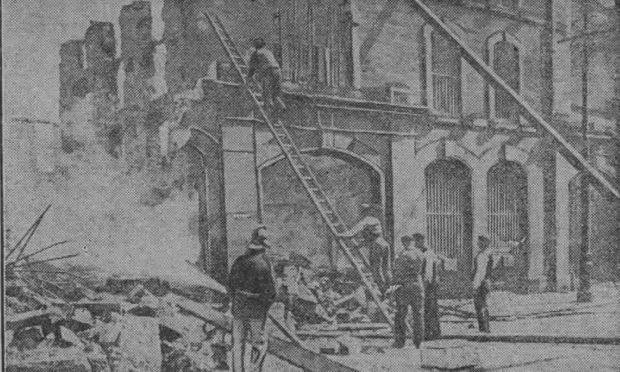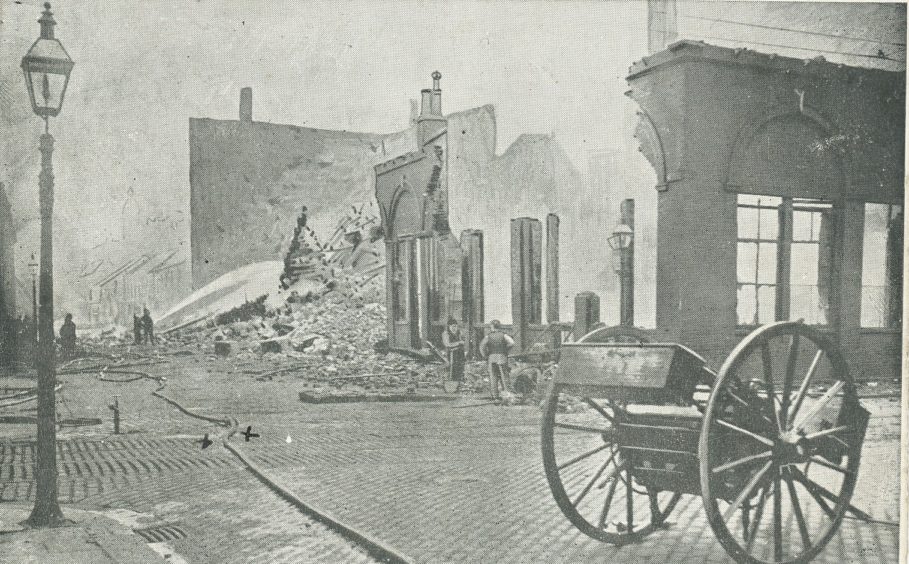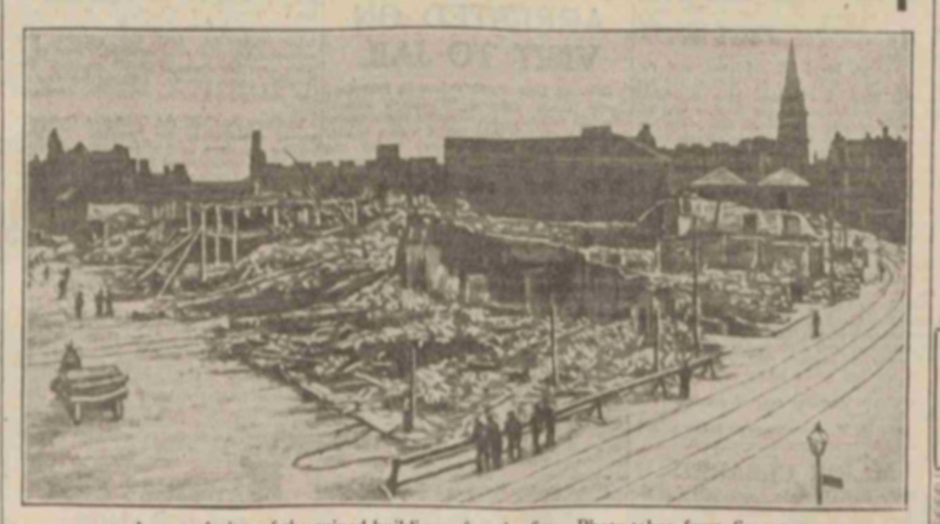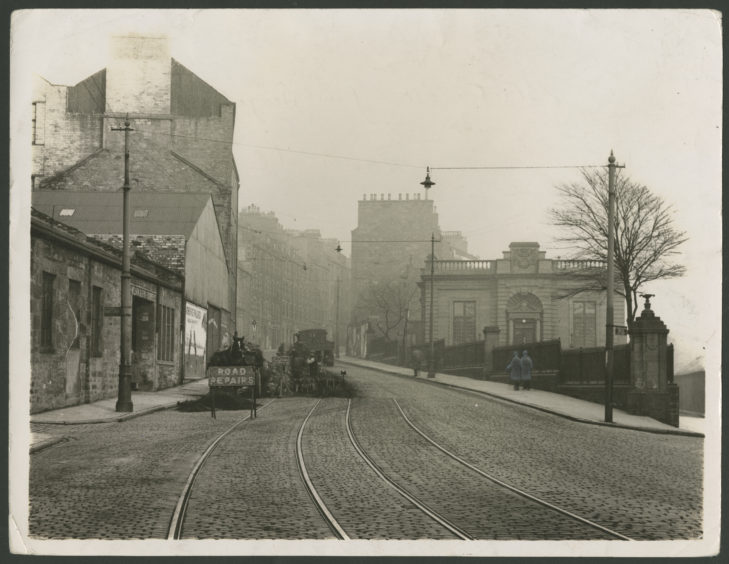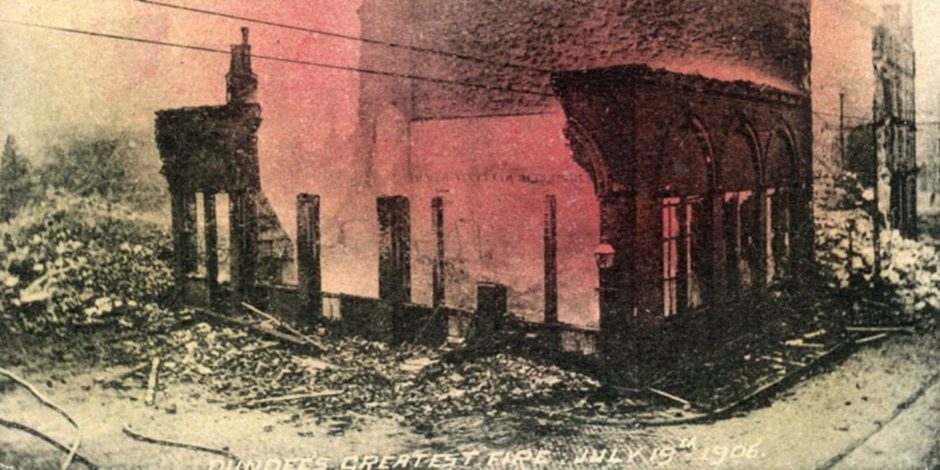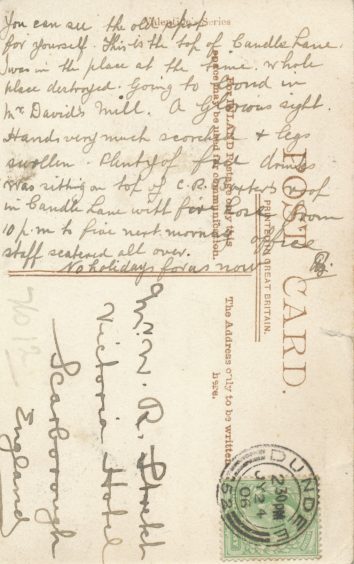It’s a story of great burning interest. Gayle Ritchie remembers the disastrous whisky bond fire in Dundee’s Candle Lane which saw two million gallons of spirits going up in flames.
Rivers of boiling whisky flowed through the streets of Dundee, with flames of alcohol whipping up into eerie flickers of green, purple and blue.
As the inferno raged, the glow was visible for 30 miles and people on the outskirts of the city were able to read their newspapers outdoors at midnight.
The fire at Watson’s Bond, at the junction of the Seagate and the aptly-named Candle Lane, broke out on July 19 1906 and burned for two days.
It was the the city’s most destructive fire ever, causing damage equivalent to £35 million in today’s money, as two million gallons of whisky went up in flames or down the drain.
It was enough, it was claimed, to provide every man in Scotland with six bottles of the hard stuff.
Blazing streams
The fire broke out at 6.20pm on a glorious summer evening in the six-storey bonded warehouse of James Watson & Co. Ltd.
This contained around two million gallons of spirits, principally whisky and rum, but also Champagne, wine and “fine old brandy”.
“Hundreds of thousands of gallons of whisky were stored in the warehouses in tanks and small casks, and as they exploded, it was as though musketry firing was proceeding,” ran a report.
“As these explosions occurred, the flames bounded higher in the air. From the upper storeys, blazing whisky flowed like a river of fire and dropped into the street – a brilliant waterfall of blaze and colour.”
Shortly before 8pm, a blending vat, having contained 7,000 gallons of whisky, burst, sending a great shaft of flame into the air and scattering debris far and wide.
The concussion of the blast smashed the windows of neighbouring houses and hurled a fireman named Inverarity right across the street.
Luckily, he hung on to his hose which acted as a brake and probably saved his life.
From the upper storeys, blazing whisky flowed like a river of fire and dropped into the street – a brilliant waterfall of blaze and colour.”
Whisky soon began to run from the windows in “blazing streams” and, cascading down into the streets, continued its fiery course.
At the corner of Trades Lane and Seagate was a one-storey building belonging to the Scottish Co-operative Wholesale Society and though every effort was made to save this, it soon caught fire.
The stores had just been stocked with 2,000 bags of sugar which, as they ignited, burned as fiercely as the fire.
The roof and walls then began collapsing, tongues of flame leaping into the air as each portion of masonry fell.
At 2am, the fire was still ablaze, and was said to have spread across an area of five acres.
A great panic prevailed with neighbouring houses blocking streets with beds, bedding and household furniture in a desperate bid to hold back the flames.
Absolutely gutted
By noon the following day, the fire was under control, although there was a major risk of collapsing masonry and explosions hailing from spirits flooding the warehouse cellars.
The Watson whisky stores were said to be “absolutely gutted” with not a penny worth of salvage.
A neighbouring bond belonging to John Robertson was also destroyed.
Two jute warehouses on the street opposite had also caught fire, and groups of men spent 12 hours pouring water onto the blazing material.
At one stage, the roof of Lindsay and Low’s bakery was seen to be alight but it was quickly extinguished.
A house in the Seagate was ignited and the householder removed herself to a place of safety.
“In the evening, the conflagration presented a thrilling and fearsome spectacle,” stated a report.
“The mass of flames had a complete sweep of the extensive premises and the explosion of whisky casks kept up a continual cannonade to the west.”
The overall loss to the owners of the bonded warehouses was said to be in the region of quarter of a million, while the damage to jute warehouses would be another £80,000, and to other properties, well on for another £100,000.
The total loss was not far short of half a million – equal to around £35 million today.
Eyewitness
Most of the staff had gone home when the blaze broke out but one man was late in leaving.
A report in the Evening Telegraph from one of his colleagues said: “He was just putting on his hat when he looked out the cloakroom window.
“He was shocked to see smoke issuing from the bond roof. At once he rushed out into the Seagate shouting, ‘The Bond’s on fire!’”
The fire brigade were said to have been hindered because the keys to the warehouse were “not handy”.
“No need for people in the west, north and east ends of the city to leave their districts to see the fire,” continued the report.
“In parts of the north and east ends, people could read their newspapers by the light from the Seagate after darkness had fallen.
“As far as Montrose, the glare was startling. From over the water it was a display of fireworks on a grand scale.”
The employee managed to break the cordon of police and firemen to secure some important books. These, he deposited in a nearby shop, out of danger.
He then attached himself, unofficially, to “a sort of private fire brigade”.
“A workman from the harbour came up Candle Lane with a fire hose and I co-opted him,” he said.
“Soon half a dozen of Watson’s warehousemen had joined us in trying to halt the fire from the back.”
While they were working, the biggest vat in the establishment, fondly known as “Long Tom”, burst, shaking the surrounding buildings to their foundations.
“As far as Montrose, the glare was startling. From over the water it was a display of fireworks on a grand scale.”
Two months after the blaze, the employee was told to come and collect his belongings, held in a safe. It had come down with the roof from the second floor of the office.
“It was slightly battered, but the books were intact except for scars on the edges of the leaves,” he recalled.
“Opening the cash drawer, I found the notes were a mass of burnt paper, the silver coins had melted and ‘run’ all over the bottom of the drawer, but there was one golden half-sovereign as clear and bright as the day it was minted.”
He kept the coin as a memento for 34 years and handed it to the Government when they appealed for gold to help the war effort.
Postcard
An eyewitness account of the inferno written on a postcard and sent to Scarborough in 1906 revealed how the sender bravely became a volunteer firefighter and suffered minor injuries.
Printed by The Post Card Studio in Broughty Ferry, the card has a photographic illustration of the conflagration on its picture side.
Addressed to the Victoria Hotel in Scarborough, it is franked with a King Edward VII green stamp and postmarked in Dundee on the afternoon of July 24 1906.
The sender’s pencil-written account states: “This is the top of Candle Lane. I was in the place at the time. Whole place destroyed. A glorious sight. Hands very much scorched and legs swollen. Plenty of free drinks. Was sitting on top of CR Baxter’s roof in Candle Lane with fire hose from 10pm to five next morning. Office staff scattered all over. No holidays for us now.”
The card was returned to Dundee by local historian Dr Norman Watson.
“The card not only shows the fire on its picture side, but provides this enthralling eyewitness account written just five days later, presumably when he had recovered,” said Norman.
“The sender spent seven hours holding a hose with scorched hands yet can ruefully joke about his holidays going up in smoke. He seems quite a character.
“This was a huge fire, which also destroyed a neighbouring bond belonging to John Robertson, a Co-op warehouse, two nearby jute warehouses and Stewart Robertson’s store of fire clay goods.
“It was also the day grown men wept as alcohol went up in flames or down the drain.”
Tragedy, a year on
A year after the blaze, in August 1907, another fire broke out in bonded stores on Seagate, resulting in two men being severely burned with one of them, Robert Young, dying of his injuries.
Young and his colleague Frank Ewing had been cleaning a whisky vat when the saturated woodwork caught fire.
The two men were completely engulfed in fire until the flames were extinguished with water.
Both men sustained serious burns to the face and arms but Young was severely burned about the body and died in Dundee Royal Infirmary.
